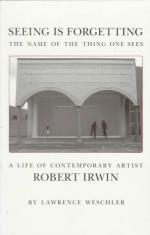
|
| Name: _________________________ | Period: ___________________ |
This test consists of 15 multiple choice questions and 5 short answer questions.
Multiple Choice Questions
1. As more of Irwin's works go on display and are sold, what happens to Irwin?
(a) The more anxious he becomes.
(b) The more confident he becomes in terms of being an artist.
(c) The more remote he becomes to them and the less interest they engender in him.
(d) The wealthier and happier he becomes.
2. Robert winds up with what group?
(a) Religious tourists.
(b) A fraternity.
(c) The paratroopers.
(d) Young artists.
3. The entrepreneur not only admires Irwin's art but also what?
(a) His religious background.
(b) His easy-going personality.
(c) His love of New York.
(d) His determination and ambition to succeed.
4. How much of an effect do the repercussions from World War II have upon Irwin and his buddies?
(a) Extremely large.
(b) Very little.
(c) None.
(d) Quite large.
5. Robert's dissatisfaction with Jepson then leads him to the Chouinard Art Institute, where he focuses on what?
(a) Dreamy watercolors.
(b) Ceramic sculpture.
(c) Abstract oil paintings.
(d) Stone carvings.
6. A gallery displaying some of Irwin's work includes in his catalog commentary that, "The art is what has happened to __________" (p. 92).
(a) The viewer.
(b) The canvas.
(c) The space.
(d) The artist.
7. How does Robert wind up in Europe?
(a) He visits friends.
(b) He attends college in Paris.
(c) He runs out of money in Rome.
(d) He is transferred to the regular Army due to an injury.
8. Questions that arise within Irwin himself about his line drawings leads him to advance to what?
(a) Cubes.
(b) Rectangles.
(c) Dots.
(d) Squares.
9. Due to his school's proximity to what, Irwin becomes interested in gambling?
(a) Casino Knights.
(b) The Hollywood Casino.
(c) Commerce Casino.
(d) The Hollywood Park Race Track.
10. From what does Irwin begin to withdraw?
(a) The gallery.
(b) The art world.
(c) The world.
(d) Himself.
11. That Irwin's childhood recollections reside mainly as _____________________ is a clue that his strong connection to the visual was present very early in life.
(a) Perfect images versus words or conversations.
(b) Words or conversations versus perfect images.
(c) Photographs he has taken.
(d) Drawings he has made.
12. After graduating from high school, Robert's buddies convince him to join them in doing what?
(a) Traveling the world.
(b) Studying art.
(c) Signing up for the military.
(d) Going to college.
13. With what does Ferus present Irwin?
(a) His first experience with contemporaries whose work is inferior to his own.
(b) His first experience with contemporaries with more art training.
(c) His first experience in a gallery setting.
(d) His first experience with contemporaries whose work is superior to his own.
14. Leider felt that Irwin created the painting to be seen how?
(a) In a way that allows all viewers to have their own interpretation.
(b) As a mentally-ill person might see life.
(c) As he designed it to be seen or to not be seen at all.
(d) As a magnificent work of art.
15. Irwin takes a giant leap between 1962 and ___________ in the production of his ten late line paintings.
(a) 1965.
(b) 1967.
(c) 1966.
(d) 1964.
Short Answer Questions
1. Blum regrets that some of the gallery's artists fail to move _______________ where they could be successful.
2. At Ferus, Robert feels the need to do what?
3. Robert loves school only for what?
4. Irwin's goal is to create art that leaves the observer how?
5. Irwin is called back to active duty in the Army during what?
|
This section contains 549 words (approx. 2 pages at 300 words per page) |

|




